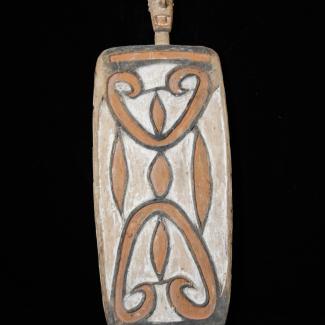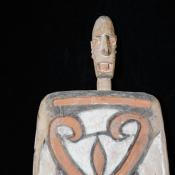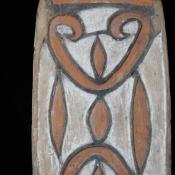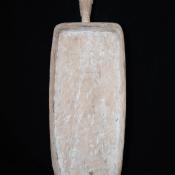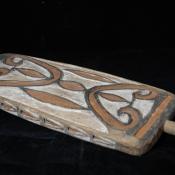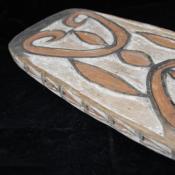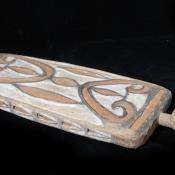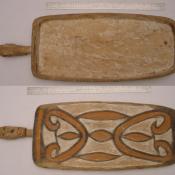This is a large rectangular sago platter crafted by peoples in the Asmat culture of Papua New Guinea, likely carved in the latter half of the twentieth century. The front curved surface is carved with a symmetrical design depicting a sago tree, which is carved half an inch into the surface and painted red. The outlines of the tree design are painted in black and the backdrop is painted in white. The sides of the platter are carved with triangular shapes set into rectangular patterns. The triangles are painted red as well. The bottom interior surface of the piece is painted white, but only remnants of the original pigment remain. The handle of the platter is carved in the shape of a male figure’s head. It features an elongated nose, prominent forehead, sunken eyes, large ears, an open smiling mouth, and a trench across both cheeks. The chin is prominent as well and the eyes, ears, and mouth are all painted red.
In many examples of Asmat art, the twin colors of white and red are prominently featured. White paint is known as mbi, which is made from mussel shells through a process burning the shells into ash. The red is called wasah and is made from muds which are gathered at riverheads and villages which reside upstream.
Platters such as this one are traditionally used by Asmat peoples for eating sago, one of the most prominent food staples of Papua New Guinea. The sago and the sago tree play a prominent role in many Asmat communities and folktales. The red coloration is considered to have magical properties and is a core aspect of an Asmat myth involving Ofomin, a man whose blood ran into the ground and mixed with the water to form red clay and mud. Platters such as these were often used to hold roasted balls of flour made from the sago palm and human brains collected in headhunting raids. The Capricorn beetle was also traditionally served in platters such as these, as they hold a ceremonial place in Asmat cuisine. It is commonly thought that the larval resemblance of the beetles to human brains contributed to their rise in popularity since the banning of headhunting practices by missionaries in the late twentieth century.
Colors: Black, Red, White, Brown

